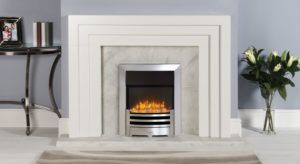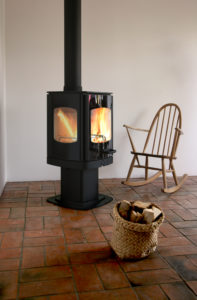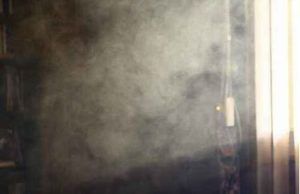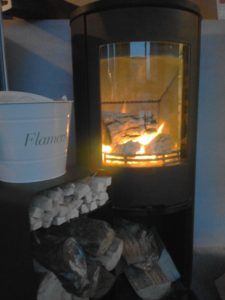Thinking of Buying a Wood Burning Stove…
… here are some thoughts to help.
FIRST THOUGHT: Fuel
As the name suggests, a wood burning stove requires wood to burn; it is therefore worth considering if the outdoor area of the property has enough room to accommodate a log shed in a suitably dry area to store the wood. On average about 3-4 cubic metres of wood will be burnt in a year – though it is not necessary to buy that quantity in bulk!
Wood should only be burnt when it has less then 20% moisture in it, a way of measuring this is by using a moisture reader. Wet wood will only steam, not give off any heat and has the potential to tar up the flue (chimney).
Kiln dried wood, if stored correctly is the best option but can be more expensive than buying seasoned wood from a local supplier.
The cheapest option, if space allows, is to buy wood that has been felled recently and leave it to season for approximately 3 years before burning.
SECOND THOUGHT: Heat
Heat being emitted from a stove is measured in kilo watts (kW). If the stove is giving off too much heat it may be that windows will have to be opened (defeating the object!) or by not having the stove hot enough the fire chamber will fill with smoke causing tar to built up within the chamber and the flue. The rule of thumb is that 1kW is required to heat 14 cubic metres of indoor space to a temperature of 21° when the outdoor temperature is 1° and will be assessed on the following
- The size of the room: height(m) x width(m) x length(m)/ 14
- the lay out of the room; ie open plan, L-shaped
- the size of the windows; single/double glazed
- other forms of heating within the room
- age and insulation of the property
As with all items that run on any form of fuel, efficiency is important. With effect from 2022 the efficiency of all wood burning stoves is to be over 80% which will mean that less wood needs to be burnt to acquire the heat needed; many off the major manufacturers have models that meet and exceed this requirement already.
THIRD THOUGHT: Style
Although not ever ending there are a number of choices in many designs and, as with all things, various prices!
FOURTH THOUGHT: Install: Hearth and flue
Building regulations state that, regardless as to whether the stove is inset or freestanding a non-combustible hearth to the depth of 300mm from the stove door has to be insitu to minimalise the risk of heat transference to combustible materials and has to be visually and physically apparent from the surrounding area.
A flue can be either a brick chimney or, where a chimney is not already insitu, a metal twin wall or pumice system.
If the brick chimney is square or oblong inside then a circular flue will need to be installed to prevent tar deposits building up in the corners which would increase the risk of a chimney fire. The void between the brick and the flue would then be back filled with vermiculite, or similar, to absorb condensation which could erode the flue.
Please note that thatch properties need to meet a higher evaluation criteria to install a wood burning stove.
A metal twin wall system is a system used when a stove is to be installed into a room where a chimney does not exist. It is made of stainless steel and as the name suggests is a flue within a flue with ‘wadding’ between the two. This system can be installed within the property should it be required or fitted to the outside wall.
A pumice system is made from interlocking pumice blocks to form an outside chimney which would flue a new fireplace where one had not existed before.
FIFTH THOUGHT: Maintenance.
Although stoves are manufactured to a high calibre it is always advisable to check the warranty conditions on the stove chosen. Some manufacturers will only give, or offer an extended, warranty through main dealers and is worth knowing that glass, rope seals, fire bricks and similar consumable parts are not usually covered by a warranty.
The chimney should be swept at least once a year, ideally as the weather starts to warm and the stove is being used infrequently to prevent any soot that may have accumulated within the flue from corroding it during the summer months. A local chimney sweep can be found by using the HETAS or NACS websites.
Just as a car benefits from a yearly service so does a stove. This can be done by a chimney sweep who will check the fire bricks, baffle and rope seals for the door(s) and advise if replacements are required.
SIXTH THOUGHT: Cosy evenings…
…watching the flames and letting the stresses of the day ebb away…Bliss!









